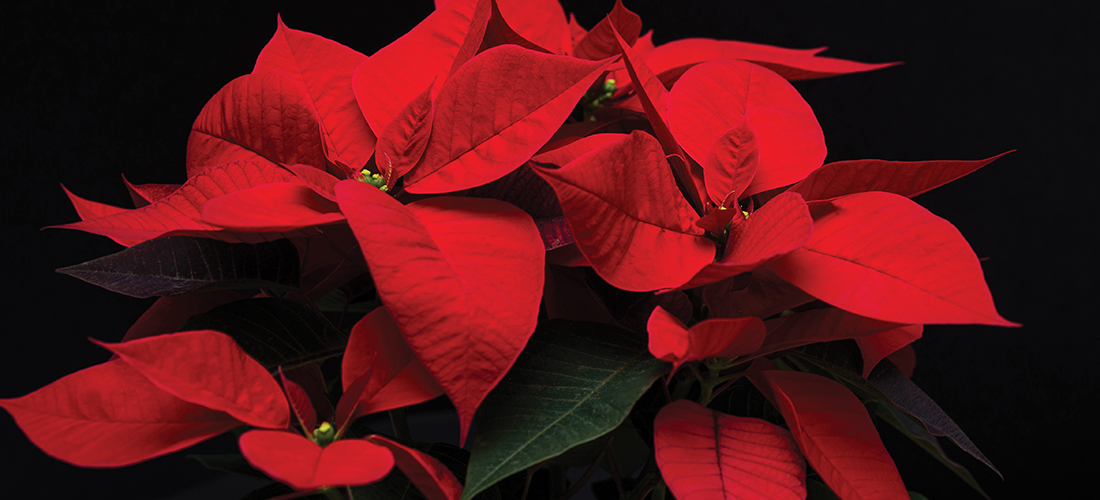
For brilliant red poinsettias, keep them under wraps
By Ross Howell Jr.
For years as a grad student and later as an itinerant bachelor, I put off buying Christmas decorations because I didn’t want to move them from one apartment to the next. Holiday decorating for me meant buying poinsettias — usually in foil-wrapped containers — to get instant seasonal cheer with minimal effort.
Besides, poinsettias have a cool history.
Indigenous to Mexico, Euphorbia pulcherrima owes its popular name to Joel Poinsett. Born in 1779 to a wealthy family in Charleston, South Carolina, Poinsett was a world traveler. President John Quincy Adams appointed him as the first Minister to Mexico in 1825. While visiting south of Mexico City, Poinsett saw a plant known among locals as Flor de Nochebuena, or “Christmas Eve flower.” An amateur botanist, Poinsett sent samples back home. Propagated and sold, the plants by 1836 had become known in the States as “poinsettias.”
So what did I do with my once-lovely poinsettias after the holidays were over? I dumped the then-desiccated plants into the trash.
As time passed, my lazy approach to holiday decorating left me feeling guiltier and guiltier.
All those plants I’d tossed. What if I’d tried to winter them over, do whatever mysterious things needed to be done to have them erupt in scarlet again the following Christmas?
Then one evening a message popped up on my neighborhood listserv.
“Is anyone in the area trying to force poinsettias? We are trying to do it but have to travel during the ‘dark time’ and need someone to tend them for us.” The sender was Tom Krissak.
Surely Krissak could give me a shortcut to poinsettia success. I mean, he already knew there was something called “dark time.”
Turns out, Krissak — retired from the funeral business — had sent the message on behalf of his partner, Samuel Johnson, who’s the gardener in their household. Krissak gave me Johnson’s number.
“Oh, I really just took up plants after I retired a couple years ago,” Johnson confesses over the phone.
He tells me he grew up in northern Virginia but has lived all over the world. A mathematician, Johnson first came to Greensboro to teach at Guilford College.
After years at Guilford, he left Greensboro for a time and studied the law, became a practicing attorney and returned to Greensboro for a second time.
“I like trying to keep plants alive,” Johnson says, “but I have just the opposite of a green thumb. If you want to talk about poinsettias, you need to call Esther Maltby.”
Maltby is a neighbor who recently stepped down after seven years as director of the Dunleith Community Garden on Chestnut Street.
“Esther and I worked out a deal,” Johnson continues. “She’s caring for the poinsettias while we’re away. If they live, we’ll split the plants between us.”
So what’s Maltby’s take on the poinsettia project?
“It’s really Samuel who’s done all the research,” Maltby says. “I just agreed to babysit.”
Maltby tells me she grew up in Pakistan, the daughter of Protestant missionaries. Her father was an engineer; her mother a teacher. Poinsettias were prolific where they lived in Pakistan, growing into bushes 8 to 12 feet tall.
“I never gave a thought to cultivating little ones,” Maltby says with a laugh.
Her strategy for forcing the poinsettias to bloom is to keep them in light—but not direct sunlight — for eight hours a day. Then she plunges them into darkness — under cardboard boxes covered by blankets — for the remaining 16 hours of the day.
When Maltby sees red bracts sprouting, she’ll stop the “dark time.” She began the process in mid-October, a little concerned about having enough time to bring the plants to full Christmas glory.
“Samuel messages me every day, asking how the poinsettias are doing,” she says. “I tell him they look good; they’re putting out lots of green leaves.”
She pauses.
“I sure hope this works,” she says.
Me, too.
Regardless, I realize now keeping poinsettias holiday-to-holiday requires way more mindfulness than a lazy guy like me can muster. PS
Ross Howell Jr. is getting ready for Elon University’s January term, when he’ll be teaching a general studies course entitled “A Brief History of Truth.”





